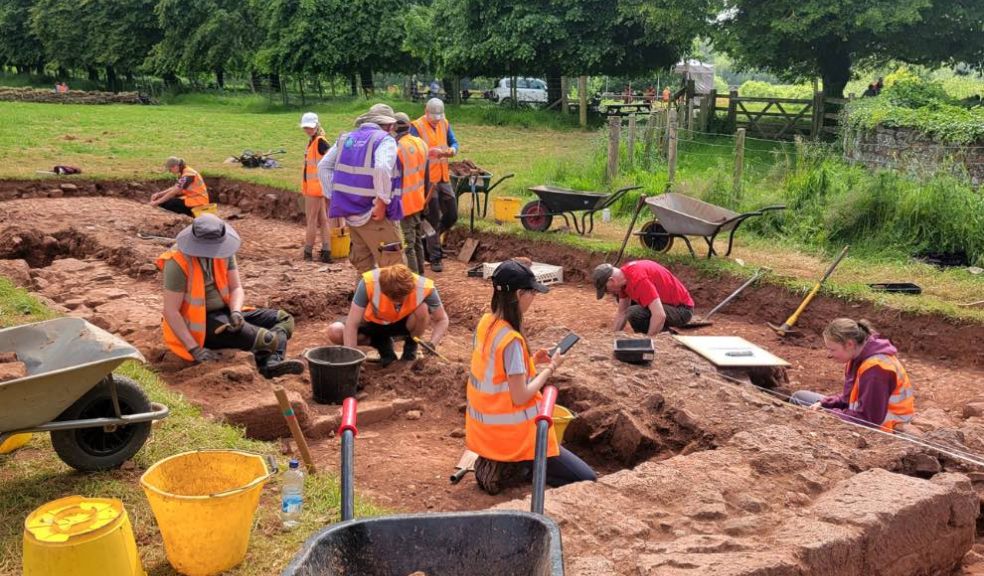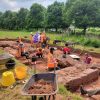
‘Lost’ Elizabethan manor house rediscovered in Devon
A long-lost Elizabethan manor house that swapped hands between the Royalists and the Parliamentarians during the English Civil War has been ‘unearthed’ by archaeology students and volunteers.
Excavations on the National Trust-managed Killerton estate in East Devon has found some of the remains of Columbjohn, the mansion that originally sat at its heart, and which once hosted Thomas Fairfax and Oliver Cromwell.
A cobbled courtyard, two ranges of buildings, parts of a demolished outer precinct wall and a probable sunken garden were all uncovered by the team, led by archaeologists at the University of Exeter, working in partnership with the National Trust, and alongside their Heritage Archaeology and Ranger Team (HART) volunteers.
A range of historical artefacts were also discovered, including 17th century coins, musket balls and personal effects.
“The substantive parts of Columbjohn are likely to date from 1580–90, when Sir John Acland is known to have purchased the manor and built a large Elizabethan mansion on the site,” says Dr Susan Greaney, Project Lead in the Department of Archaeology and History at Exeter. “However, the only standing remains today are an outer gatehouse and some nearby farm buildings. After the family relocated to the main house at Killerton, and the manor was demolished in the early Victorian period, the location and layout of the house were entirely forgotten.”
Guided by previous geophysical and earthwork surveys, the team opened five different trenches and two test pits to locate the manor house, as well as investigate field boundaries, ditches, and a large enclosure in the area. They uncovered substantial stone walls, interior floor surfaces and a cobbled courtyard with drains and post pads that may have supported a wooden roof.
Working on the site since mid-May, the students and HART volunteers also found a twisted glass stem from a 17th century fine drinking glass; a pipe tamper ring; a double-sided bone comb; a large key, located in one of the drains; and a variety of coins, pins and buttons.
Dr Barbara Wood, National Trust Cultural Heritage Curator, said: “We knew that the original house bought by Sir John Acland was somewhere at Columbjohn and it’s amazing to have the location finally found. The two were joined by an avenue of trees and the family would have regularly walked between them. We’re delighted that so many visitors have seen the excavations underway, and we hope that many more will continue to take the walk between the site of the old house and the new.”
Now that the house has been rediscovered, the archaeologists can begin to piece together the more detailed phasing and layout of the house, which is understood to have been built of local volcanic stone, with a slate roof capped by green glazed ridge tiles, and with windows and other architectural features using stone imported from South Devon.
It is also thought that prior to Acland purchasing the site, there was a pre-existing house that had been built by the previous owners, the Courtenays – so the area may well have been occupied for 600 years.
Acland's mansion, likely to be on the site of the manor mentioned in the Domesday Book, played an important role during the Civil War, hosting a garrison of troops loyal to King Charles I. The find of several unused musket balls indicate that soldiers were indeed based here. Later in the Civil War, the house was taken over by the Parliamentarians, and Thomas Fairfax used it as his headquarters during the Siege of Exeter; Oliver Cromwell is thought to have stayed in October 1645.
The Acland family remained in seat when the war finished, and once they had made Killerton their main house from around 1680, the mansion decayed, with just its chapel being used for Sunday services. Eventually they demolished it, building a new chapel in its place in the 1840s.
Cat Lodge, National Trust Archaeologist, said: “Our partnership with Exeter is adding more depth to our understanding of the Killerton estate, with its rich historic landscape. Excavating this site has helped shape future plans for Columbjohn, providing us with an opportunity to integrate heritage with landscape recovery. Thank you to everyone who has been involved with the excavation, and we look forward to continuing this exciting partnership.”
“It’s been really exciting to excavate in such a beautiful location at a place that has such a significant history,” added Dr Greaney. “Finding the manor house, the original heart of the Killerton estate, is fantastic, and our students have worked really hard to uncover the structures and finds relating to the house.”


















